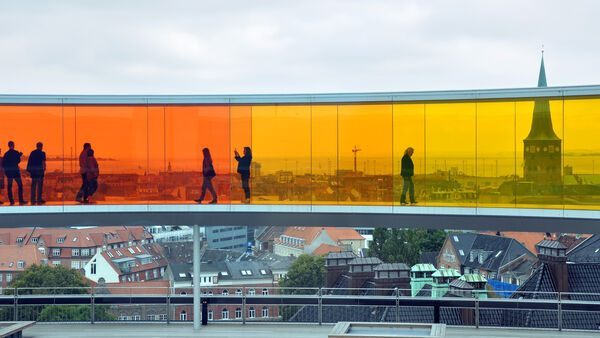Aarhus: Denmark’s Biggest Little Town
By Rick Steves

Aarhus, Denmark's second-largest city, calls itself the "World's Smallest Big City." I'd argue it's more like the world's biggest little town: easy to handle and easy to like. A pleasant three-hour train ride from Copenhagen, Aarhus is well worth a stop.
Aarhus is the lively cultural hub of Jutland, the part of Denmark that juts up from Germany — a land of windswept sandy beaches, inviting lakes, and fortified old towns. It's also one of the oldest cities in Scandinavia. When its Viking founders settled here in the eighth century, they were attracted to its strategic location, where a river hits the sea.
Today, Aarhus bustles with a buzzing port, an important university, a bursting-with-life pedestrian boulevard, and an adorable old quarter filled with people living well. This "second city" enjoys a friendly competition with Copenhagen, whose sophisticates sniff that there's no need for intercity rail connections in Denmark because there's only one city — theirs. But modern Aarhus is elbowing its way into the itineraries of tourists with some notable attractions and a thriving street scene.
The Aarhus art museum — called ARoS — is a must-see sight, thanks to a statement contemporary building and a curatorial staff who have a knack for making cutting-edge art accessible and fun. One of the biggest draws is a work by Olafur Eliasson, Your Rainbow Panorama — a 360-degree walkway that perches on the rooftop like a rainbow-colored halo. My favorite piece in the collection is one very big Boy by the Australian artist Ron Mueck. This superrealistic crouching figure, nearly 16 feet tall, always stops me in my tracks.
If modern art isn't your thing, check out Aarhus's more traditional fare, including a fine open-air museum known as Den Gamle By (The Old Town). With 80 historic buildings carefully moved here from throughout Denmark, it gives visitors the best possible look at Danish urban life in decades past. Don't be afraid to open doors or poke into seemingly abandoned courtyards — you'll likely find a chatty docent inside, dressed in period attire eager to describe the artifacts, answer questions, or demonstrate a craft such as blacksmithing or beekeeping.
You can travel even farther back in time at the town's Viking Museum. In 1960, when a new bank was being built in downtown Aarhus, local archaeologists had a chance to excavate the site. Working their way down through the layers of time, they uncovered a section of the long-ago Viking town, including the remains of houses, wells, streets, tools, and pottery. Most curiously, they discovered the headless skeleton of a man — possibly Aarhus's oldest murder victim. The artifacts are now on display in a basement museum just off Cathedral Square.
Aarhus has another famous corpse — the Grauballe Man, the world's best-preserved "bog man." Archaeologists think he was a sacrificial victim, killed more than 2,000 years ago and tossed into a peaty swamp. Because of the oxygen-free, acidic environment, he looks like a fellow half his age. He's displayed on the outskirts of town at the Moesgård Museum, which is dedicated to prehistory and ethnography.
The city also has a fascinating exhibit about life under Nazi rule during World War II. Aarhus's police station, used by the Nazi occupiers for their Gestapo headquarters from 1940 until 1945, now hosts Occupation Museum, telling the story of the Danish resistance. Each visitor receives an ID card and follows that person's life through the war as they grapple with sticky situations and moral dilemmas.
But there's more to Aarhus than museums. As you wander the streets, the city just entertains. The higgledy-piggledy Latin Quarter, encompassing six or eight square blocks, is the oldest quarter, built in the late 14th century after the city knocked down the old Viking fortifications. This area is great for shopping, cafés, and strolling. Its streets have historical names like Klostergade (Convent Street), Volden (The Rampart), and Badstuegade (Bath Street) — from the time when the riffraff visited public bathhouses for their annual "Christmas bath" (finer folk bathed monthly).
Another fun people zone stretches alongside the town's canal (Aboulevarden). In the 1930s, Aarhus covered over its river to make a new road, but in the 1980s, locals decided to remove the road. They artfully canalized the river, creating a trendy avenue that's now the town's place to see and be seen. Lined with modern eateries, the street stays lively even after the short Danish summer fades away.
With its vibrant mix of youthful energy and respect for the past, Aarhus is a dynamic place. As the locals like to say, "Aarhus" is Danish for "progress."

